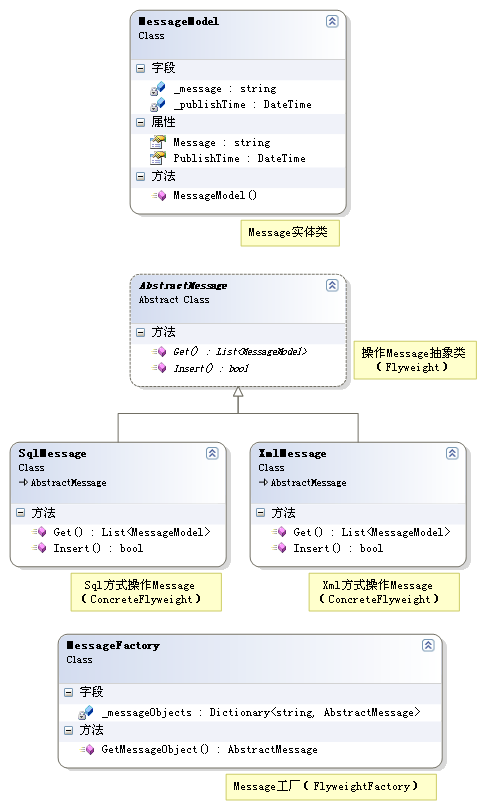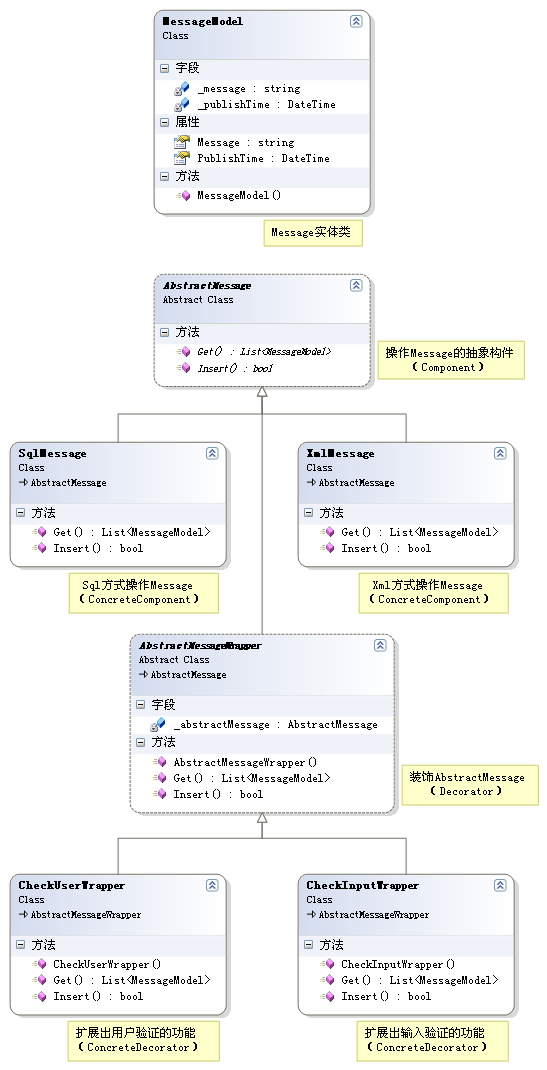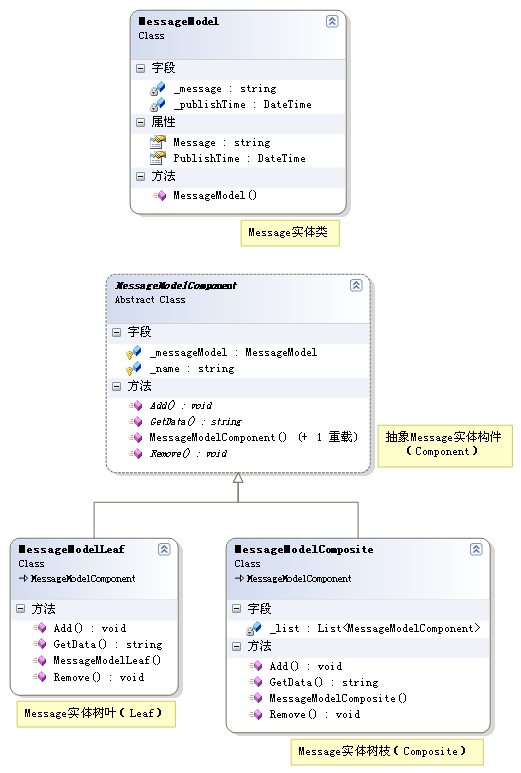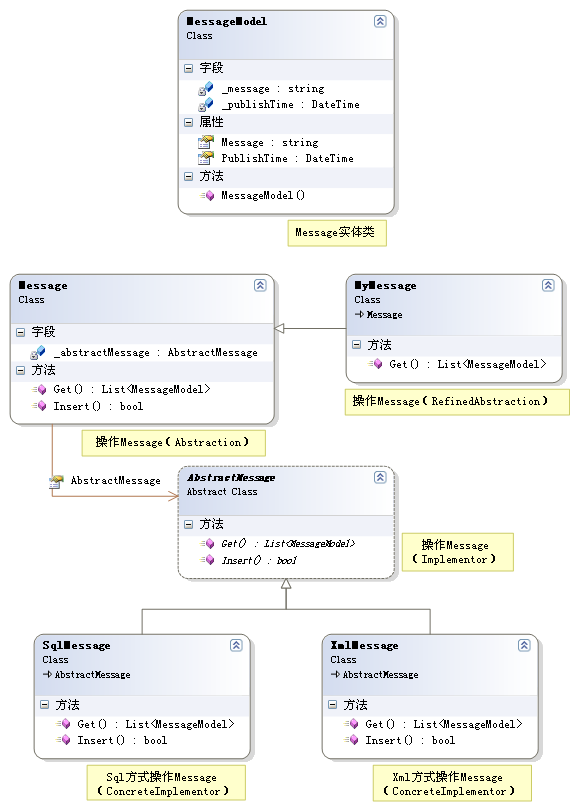 設計模式(C#) - 代理模式(Proxy Pattern)(2)
設計模式(C#) - 代理模式(Proxy Pattern)(2)
IMessageusing System;using System.Collections.Generic;using System.Text;namespa
 設計模式(C#) - 享元模式(Flyweight Pattern)(1)
設計模式(C#) - 享元模式(Flyweight Pattern)(1)
返回“設計模式(C#)系列文章索引”介紹運用共享技術有效地支持大量細粒度的對象。示例有一個Message實體類,某些對象對它的操作有Insert()和Get(
 設計模式(C#) - 享元模式(Flyweight Pattern)(2)
設計模式(C#) - 享元模式(Flyweight Pattern)(2)
AbstractMessageusing System;using System.Collections.Generic;using System.Text;
 設計模式(C#) - 享元模式(Flyweight Pattern)(3)
設計模式(C#) - 享元模式(Flyweight Pattern)(3)
XMLMessageusing System;using System.Collections.Generic;using System.Text;names
 設計模式(C#) - 享元模式(Flyweight Pattern)(4)
設計模式(C#) - 享元模式(Flyweight Pattern)(4)
Testusing System;using System.Data;using System.Configuration;using System.Coll
 設計模式(C#) - 裝飾模式(Decorator Pattern)(1)
設計模式(C#) - 裝飾模式(Decorator Pattern)(1)
返回“設計模式(C#)系列文章索引”介紹動態地給一個對象添加一些額外的職責。就擴展功能而言,它比生成子類方式更為靈活。示例有一個Message實體類,某個對象
 設計模式(C#) - 裝飾模式(Decorator Pattern)(2)
設計模式(C#) - 裝飾模式(Decorator Pattern)(2)
MessageModelusing System;using System.Collections.Generic;using System.Text;nam
 設計模式(C#) - 裝飾模式(Decorator Pattern)(3)
設計模式(C#) - 裝飾模式(Decorator Pattern)(3)
SqlMessageusing System;using System.Collections.Generic;using System.Text;names
 設計模式(C#) - 裝飾模式(Decorator Pattern)(4)
設計模式(C#) - 裝飾模式(Decorator Pattern)(4)
AbstractMessageWrapperusing System;using System.Collections.Generic;using Syste
 設計模式(C#) - 裝飾模式(Decorator Pattern)(5)
設計模式(C#) - 裝飾模式(Decorator Pattern)(5)
CheckInputWrapperusing System;using System.Collections.Generic;using System.Tex
 設計模式(C#) - 裝飾模式(Decorator Pattern)(6)
設計模式(C#) - 裝飾模式(Decorator Pattern)(6)
Testusing System;using System.Data;using System.Configuration;using System.Coll
 設計模式(C#) - 組合模式(Composite Pattern)(1)
設計模式(C#) - 組合模式(Composite Pattern)(1)
返回“設計模式(C#)系列文章索引”介紹將對象組合成樹形結構以表示“部分-整體”的層次結構。它使得客戶對單個對象和復合對象的使用具有一致性。示例有一個Mess
 設計模式(C#) - 組合模式(Composite Pattern)(2)
設計模式(C#) - 組合模式(Composite Pattern)(2)
MessageModelusing System;using System.Collections.Generic;using System.Text;nam
 設計模式(C#) - 組合模式(Composite Pattern)(4)
設計模式(C#) - 組合模式(Composite Pattern)(4)
MessageModelLeafusing System;using System.Collections.Generic;using System.Text
 設計模式(C#) - 組合模式(Composite Pattern)(5)
設計模式(C#) - 組合模式(Composite Pattern)(5)
MessageModelCompositeusing System;using System.Collections.Generic;using System
 設計模式(C#) - 橋接模式(Bridge Pattern)(1)
設計模式(C#) - 橋接模式(Bridge Pattern)(1)
返回“設計模式(C#)系列文章索引”介紹將抽象部分與它的實現部分分離,使它們都可以獨立地變化。示例有一個Message實體類,對它的操作有Insert()和G
 設計模式(C#) - 橋接模式(Bridge Pattern)(2)
設計模式(C#) - 橋接模式(Bridge Pattern)(2)
MessageModelusing System;using System.Collections.Generic;using System.Text;nam
 設計模式(C#) - 橋接模式(Bridge Pattern)(3)
設計模式(C#) - 橋接模式(Bridge Pattern)(3)
MyMessageusing System;using System.Collections.Generic;using System.Text;namesp